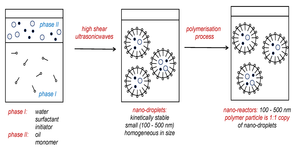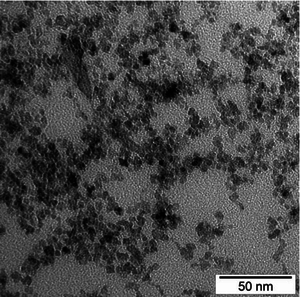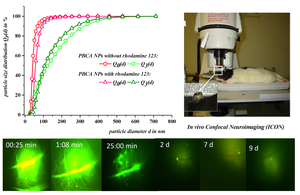Nano-Particles
Production of nano-particles by polymerization, crystallization and precipitation
Another focus of the Chair is on the targeted production of nano-particulate systems by controlled chemical processes, such as polymerization, crystallization and precipitation in aqueous environment on a laboratory scale. These successful experiments are used to produce particles with specifically desired physical application properties (particle formulation). This has led to the optimization of nano-particle formulations with regard to blood-brain barrier mobility, such as the fabrication of surface-modified fluorescent as well as siRNA-incorporated Poly(butylcyanoacrylate) (PBCA) nanoparticles to cross the blood-brain barrier.

Tailor-made up-converting core-shell NaYF4 nanoparticles (UCNPs)
Lanthanide up-converting luminescent nanoparticles (UCNPs) are exciting and promising materials for optical bioimaging, biosensor and theranostics. These UCNPs are characterised by the fact that they absorb low energy near infrared (NIR) light and emit high-energy visible light of shorter wavelength. The NaYF4 NPs shall meet some requirements of high fluorescent intensity, small diameter, nearly monodisperse particle size distribution, water solubility and low cytotoxicity. A main challenge is to control size, shape and composition of the prepared nanoparticles in that way that the excitation NIR wavelength is 980 nm; the emitting wavelength is in blue light range.
Single-domain magnetic nanoparticles for drug delivery systems
Magnetite (Fe3O4) nanoparticles have attracted considerable interest due to their attractive properties, such as their strong magnetic moment, biocompatibility, and chemical stability. The particle size, which is related to the magnetic domain structure, has been recognised as a key factor in the application of magnetic NPs. There are several essential feature, which need to be followed for the development of successful magnetic drug delivery vehicles. The magnetic NPs need to be sufficiently large to possess high magnetization for efficient magnetic targeting. They have to allow controlled drug uptake and release mechanisms to make them to efficient delivery systems. Finally, they have to possess theranostic features (both diagnostic and therapeutic) to enhance the delivery and the drug action.

Surface-modified Poly(butylcyanoacrylate) (PBCA) nanoparticles for blood-brain barrier crossing
The blood-brain barrier (BBB) is acting as a firewall to protect the brain from hazardous substances such as toxic chemicals, bacteria and viruses by its selective and specific up-take mechanisms. However, on the other hand, the “firewall” also prevents almost 95% of the pharmaceuticals, which perform potentially active functions for brain diseases from penetration. When facing this challenge, tailor-made surface modified polymer nanoparticles that have been found as a novel drug carrier showed a great suitability for the penetration of BBB. PBCA NPs are accessible by applying a mini-emulsion polymerization process, wherein the polymerization takes place in separated compartments, i.e. in so-called "nano-reactors". Surface modification and functionalization can be carried out simultaneously or subsequently with appropriate pharmaceutical agents, fluorescent markers, various receptors, contrast agents, etc.
In vivo visualisation of modified PBCA nano-particles in the tissue of the central nervous system.

